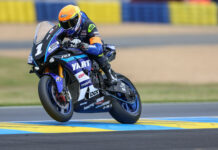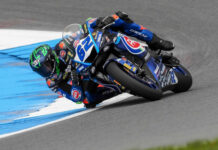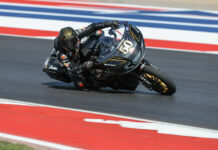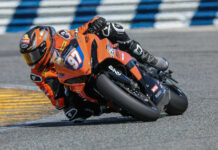From a press release:
Japanese Grand Prix
Suzuka April 5/6/7 2002
MotoGP WELCOMES FOUR-STROKE BOOM
The much-awaited 2002 MotoGP World Championship roars into action at Suzuka this weekend with a whole new sound. Booming four-stroke machines are expected to be out front for the first time in a quarter of a century of GP racing, thanks to a new technical format which pitches all-new 990cc four-strokes into battle with the screaming 500cc two-strokes.
Marlboro Yamaha Team riders Max Biaggi and Carlos Checa are expected to be in the thick of the battle aboard their awesome YZR-M1s. Second and sixth in last year’s final 500 World Championship, the pair have been hard at work developing the M1 throughout the winter, and now they are ready to give the bike its race debut, taking on rival four-strokes from Aprilia, Honda and Suzuki, as well as a bunch of the latest 500s.
Suzuka is the first of 16 races counting towards the first-ever MotoGP World Championship. After Sunday the paddock crosses the globe to South Africa, before returning to racing’s European heartland for the start of the long European campaign. The 2002 season ends in Valencia on November 3, after another series of ‘flyaway’ races, including the Pacific GP at Japan’s Motegi circuit on October 6.
BIAGGI: READY TO ROCK
Max Biaggi rode a superb 2001 season aboard his Marlboro Yamaha Team YZR500, winning three GPs and fighting for the World Championship until the last few races. It was the Italian’s best 500 campaign since switching to the premier class in 1998 but now he faces a whole new challenge – racing and developing Yamaha’s YZR-M1 in its first MotoGP World Championship season.
Biaggi has never raced a four-stroke before but he’s had little difficulty adapting to the different demands of the M1 – coping with the four-stroke’s extra weight and extra engine braking into corners. “I like Suzuka but every track is like a new track with the four-stroke, it’s a new bike, with a new system,” says Biaggi, who holds the current lap record. “Riding the M1 is very different from the two-stroke, so I’ll need to do many laps in practice but I think the bike can be faster than the 500.”
During last weekend’s Suzuka IRTA tests Biaggi came within a fraction of his best-ever 500 time, even though rain prevented him from riding his traditional end-of-session hot lap. In recent weeks Yamaha has been working on various upgrade parts, including engine internals. “We’ve been working on horsepower parts to increase acceleration and top speed,” says M1 project leader Ichiro Yoda. “I think we should have something like an extra seven horsepower for Suzuka.”
Many of these new parts have been requested by Biaggi, who has been working hard to increase the M1’s performance both on the straights and through the corners. Like any racer, he wants his motorcycle to be the best on the grid, and problems encountered at slower, tighter tracks like Estoril and Valencia have kept both him and his Yamaha engineers very busy over the last two months.
“We’ve been trying to find out what we can do to make the bike work better,” adds Biaggi. “My biggest problem had been turn-in and mid-corner turning so Yamaha gave us a new chassis for last weekend’s tests. It turns better but I’d still like the bike to turn faster. We’re also working at improving the throttle-to-tyre connection because the engine hits too hard, and that loses me time on the corner exits. I’m positive but we also have to be realistic. I will try my best on the racetrack and expect the factory to respond soon with the parts we need.”
CHECA’S NEW ERA
Carlos Checa has been looking forward to the dawning of MotoGP’s new four-stroke age more keenly than most of his fellow former 500 riders. The Spaniard prefers the riding character of the new machines and was the first man to illustrate their enormous potential when he used a YZR-M1 to shatter lap and race records during tests at Brno last summer.
“The four-stroke engine gives more traction both on corner entry and exit, it helps to hug the bike to the ground into the corner,” he says. “And when you open the throttle the power is very smooth and progressive, so you can open the throttle earlier. That’s why I prefer four-strokes. And the four-stroke character really suits Suzuka, so I’m optimistic.”
Now he’s ready to give his Marlboro Yamaha Team M1 four-stroke its race debut at Suzuka. Checa has been a crucial part of the M1 development process and has been hugely impressed by Yamaha’s dedication to their latest GP bike project.
“This year this team has more resources and more interest to develop the bike around me and Max,” he says. “We have worked very hard at developing this bike, I’ve ridden more than 6000 kilometres since November, we made good progress during last weekend’s Suzuka tests and for sure we can keep improving. But I feel confident and comfortable with the M1, I can play with it and have fun, and that’s when you’re fast.”
But after confronting his four-stroke rivals for the first time at last month’s IRTA tests at Catalunya he knows that winning won’t be easy. “From what we’ve seen (Valentino) Rossi will be the guy to beat at Suzuka, he’s consistent and fast. We need to improve but I’m optimistic. It’s going to be great at Suzuka – everyone’s been waiting for this first race of the new era, waiting to see how the four-strokes work against the 500s in a race situation. Many people think they know what will happen, but you never know until everyone goes racing.”
One of Checa’s main focuses in recent months has been improving the M1’s corner-exit performance. The bike has a lot of horsepower and its rear Michelin offers so much grip that Checa has had difficulty keeping the front wheel on the tarmac. “I can use a lot of throttle while leaned over and that causes rearward weight transfer which unweights the front tyre, which doesn’t help the steering.” This is a typical racing process: when you improve one aspect of performance, you must improve another.
WHAT THE CREW SAYS
Fiorenzo Fanali, Max Biaggi’s chief engineer
Few GP engineers have more experience than Fiorenzo Fanali, who has been working with Biaggi for the last two seasons. The Italian first began wielding spanners on the GP circuit in the late sixties when he worked for legendary Italian marque MV Agusta. Like Biaggi, he can’t wait to start the new season.
“For sure, I think the four-strokes will win at Suzuka, it’s a fast track and that should be good for them,” he says. “But, of course, every racetrack is a new story. Much will depend on the weather – it often rains at Suzuka and that could spoil the qualifying or the race. Max always wants his bike to be as easy handling as possible and that’s particularly true at Suzuka, where there are a lot of direction changes. So our focus will be to make the bike easy to steer and turn.”
Antonio Jimenez, Carlos Checa’s chief engineer
This is Antonio Jimenez’s first race as Checa’s engineer, even though he has known Checa for the past 12 years and worked with him in other capacities. A former Showa suspension technician, Jimenez is an expert at bike set-up and also knows how to get the best out of his rider.
“It’s great to be working with Carlos this year,” he says. “We’ve done a lot of testing together over the winter and our current priority for development is adjusting the balance of the bike to help keep the front on the ground under acceleration, to help him steer out of the corners. At the moment I’d say that Rossi is one or two steps ahead of us but I think our race pace is pretty good and anything can happen over 20 laps, so we’ve got to be optimistic.”
THE TRACK
Suzuka was constructed by Honda in 1962 as Japan’s first international-standard racetrack and still rates as one of the world’s best motorsport venues. The circuit staged its first World Championship rounds in ’63, ’64 and ’65 but those events only catered for the smaller classes and it wasn’t until 1987 that Suzuka hosted a 500 Grand Prix.
Since then the fast, varied and supremely challenging track has gained a reputation for serving up some of the closest, most thrilling GP encounters – Max Biaggi’s runaway win aboard his Marlboro Kanemoto Honda at the ’98 event was a rare event.
Suzuka is the longest track on the GP calendar and unique for its figure-of-eight layout which gives a good mix of left and right-handers through its 19 corners, varying from fast sweepers to the dead-stop chicane and hairpin. It is also one of the few current GP tracks where MotoGP riders can give their machines full rein.
Lap record
Max Biaggi (Marlboro Kanemoto Honda) 1998
2m 06.746s/166.556kmh
MAX BIAGGI DATA LOG
Age: 30.
Lives: Monaco
Bike: Marlboro Yamaha Team YZR-M1
GP victories: 37 (8 x 500, 29 x 250)
First GP victory: South Africa, 1992 (250)
First GP: France, 1991 (250)
GP starts: 149 (62×500, 87×250)
Pole positions: 48 (15×500, 33×250)
First pole: Europe, 1992 (250)
World Championships: 4 x 250 (’94, ’95, ’96, ’97)
Suzuka 2001 results. Grid: 3rd. Race: 3rd
CARLOS CHECA DATA LOG
Age: 29.
Lives: Great Ayton, England
Bike: Marlboro Yamaha Team YZR-M1
GP victories: 2 (500)
First GP victory: Catalunya, 1996 (500)
First GP: Europe, 1993 (125)
GP starts: 120 (92×500, 27×250, 1×125)
Pole positions: 1 (500)
First pole: Spain, 1998 (500)
Suzuka 2001 results. Grid: 12th. Race: 10th
Marlboro Yamaha Previews MotoGP Opener At Suzuka
Marlboro Yamaha Previews MotoGP Opener At Suzuka
© 2002, Roadracing World Publishing, Inc.






